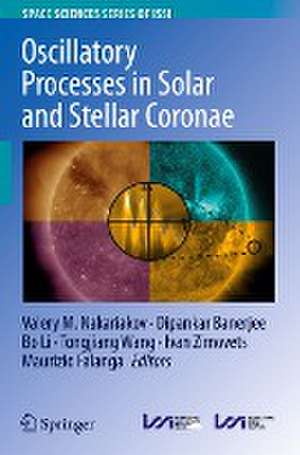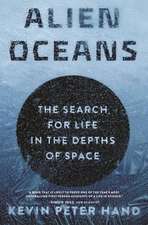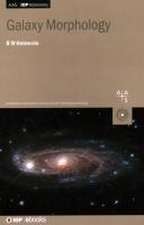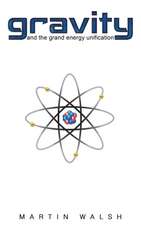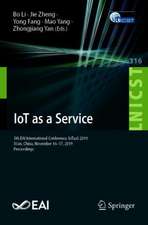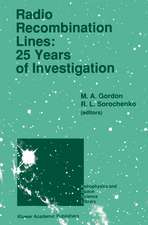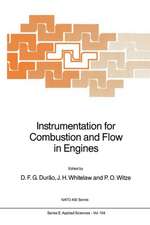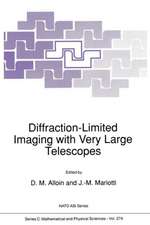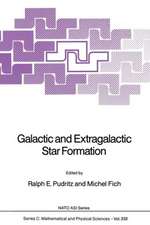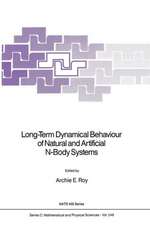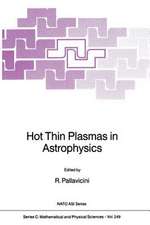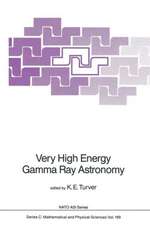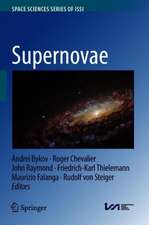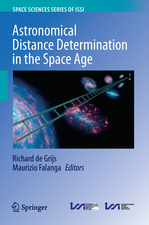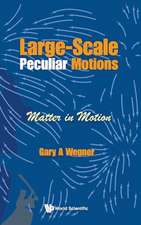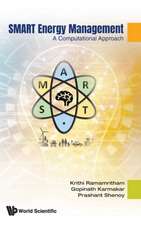Oscillatory Processes in Solar and Stellar Coronae: Space Sciences Series of ISSI, cartea 76
Editat de Valery M. Nakariakov, Dipankar Banerjee, Bo Li, Tongjiang Wang, Ivan Zimovets, Maurizio Falangaen Limba Engleză Paperback – 11 ian 2024
The book presents a broad and in-depth overview of recent achievements and the current state of research in magnetohydrodynamic (MHD) oscillatory and wave phenomena in the coronae of the Sun and stars. Major progress in coronal wave studies has been achieved thanks to the combination of high-precision multi-wavelength observations with spaceborne and ground-based facilities, elaborated theory of the interaction of MHD waves with plasma non-uniformities, state-of-the-art numerical simulations, and novel data analysis techniques. It has allowed the research community to reach a new look at the role played by MHD wave processes in the enigmatic phenomena of coronal plasma heating and wind acceleration as well as powerful energy releases such as flares and coronal mass ejections. In addition, the waves are intensively used as natural probes in the remote diagnostics of the coronal plasma parameters and physical processes operating in solar and stellar coronae via the method of MHD seismology. Individual chapters cover recent cutting-edge results obtained on the analysis and theoretical modelling of several most intensively studied coronal MHD wave phenomena, namely, kink and sausage oscillations of coronal loops and other field-aligned plasma structures, plus running and standing slow magnetoacoustic waves. A dedicated chapter assesses the reliability of proposed theoretical mechanisms for heating of the coronal plasma by MHD waves. Another chapter summarizes the current state of our understanding of the physical mechanisms and observational properties of quasi-periodic pulsations in solar flares, considers their analogy with similar processes detected in stellar flares, and thus establishes solid ground for the further exploitation of the solar-stellar analogy. An important discussion of novel data analysis techniques designed recently for MHD seismology applications is presented in a devoted chapter. The direction of future advances in the designated research areas are discussed.
The book is a spin-off from the Topical Collection "Oscillatory Processes in Solar and Stellar Coronae" of the journal Space Science Reviews.
| Toate formatele și edițiile | Preț | Express |
|---|---|---|
| Paperback (1) | 731.41 lei 6-8 săpt. | |
| SPRINGER NETHERLANDS – 11 ian 2024 | 731.41 lei 6-8 săpt. | |
| Hardback (1) | 739.81 lei 3-5 săpt. | |
| SPRINGER NETHERLANDS – 10 ian 2023 | 739.81 lei 3-5 săpt. |
Din seria Space Sciences Series of ISSI
- 15%
 Preț: 654.30 lei
Preț: 654.30 lei - 18%
 Preț: 1019.49 lei
Preț: 1019.49 lei - 15%
 Preț: 647.27 lei
Preț: 647.27 lei - 18%
 Preț: 959.50 lei
Preț: 959.50 lei - 18%
 Preț: 1406.98 lei
Preț: 1406.98 lei - 18%
 Preț: 904.91 lei
Preț: 904.91 lei - 18%
 Preț: 1123.35 lei
Preț: 1123.35 lei - 18%
 Preț: 908.36 lei
Preț: 908.36 lei - 18%
 Preț: 903.93 lei
Preț: 903.93 lei - 20%
 Preț: 577.35 lei
Preț: 577.35 lei - 18%
 Preț: 1115.46 lei
Preț: 1115.46 lei - 18%
 Preț: 1009.70 lei
Preț: 1009.70 lei - 18%
 Preț: 796.61 lei
Preț: 796.61 lei - 18%
 Preț: 739.81 lei
Preț: 739.81 lei - 18%
 Preț: 899.21 lei
Preț: 899.21 lei - 18%
 Preț: 1126.52 lei
Preț: 1126.52 lei - 18%
 Preț: 1016.01 lei
Preț: 1016.01 lei - 18%
 Preț: 1398.80 lei
Preț: 1398.80 lei - 15%
 Preț: 545.15 lei
Preț: 545.15 lei -
 Preț: 436.35 lei
Preț: 436.35 lei -
 Preț: 430.59 lei
Preț: 430.59 lei - 18%
 Preț: 983.65 lei
Preț: 983.65 lei -
 Preț: 412.78 lei
Preț: 412.78 lei - 18%
 Preț: 956.50 lei
Preț: 956.50 lei - 18%
 Preț: 950.52 lei
Preț: 950.52 lei - 18%
 Preț: 951.29 lei
Preț: 951.29 lei - 24%
 Preț: 1060.12 lei
Preț: 1060.12 lei - 18%
 Preț: 958.88 lei
Preț: 958.88 lei - 24%
 Preț: 788.97 lei
Preț: 788.97 lei - 15%
 Preț: 707.00 lei
Preț: 707.00 lei - 18%
 Preț: 951.59 lei
Preț: 951.59 lei - 24%
 Preț: 1052.17 lei
Preț: 1052.17 lei - 20%
 Preț: 574.08 lei
Preț: 574.08 lei - 18%
 Preț: 964.10 lei
Preț: 964.10 lei - 15%
 Preț: 647.40 lei
Preț: 647.40 lei - 18%
 Preț: 961.55 lei
Preț: 961.55 lei - 18%
 Preț: 964.23 lei
Preț: 964.23 lei
Preț: 731.41 lei
Preț vechi: 891.96 lei
-18% Nou
Puncte Express: 1097
Preț estimativ în valută:
139.100€ • 152.12$ • 117.68£
139.100€ • 152.12$ • 117.68£
Carte tipărită la comandă
Livrare economică 21 aprilie-05 mai
Preluare comenzi: 021 569.72.76
Specificații
ISBN-13: 9789402421989
ISBN-10: 940242198X
Pagini: 386
Ilustrații: VII, 386 p. 132 illus., 112 illus. in color.
Dimensiuni: 155 x 235 mm
Greutate: 0.55 kg
Ediția:1st ed. 2023
Editura: SPRINGER NETHERLANDS
Colecția Springer
Seria Space Sciences Series of ISSI
Locul publicării:Dordrecht, Netherlands
ISBN-10: 940242198X
Pagini: 386
Ilustrații: VII, 386 p. 132 illus., 112 illus. in color.
Dimensiuni: 155 x 235 mm
Greutate: 0.55 kg
Ediția:1st ed. 2023
Editura: SPRINGER NETHERLANDS
Colecția Springer
Seria Space Sciences Series of ISSI
Locul publicării:Dordrecht, Netherlands
Cuprins
00 Editorial / Preface (book) (Editors: Nakariakov, V.M., et al.).- 01 MHD waves in open coronal structures (Banerjee, D., et al.).- 02 Kink oscillations of coronal loops (Nakariakov, V.M., et al.).- 03 Slow-Mode Magnetoacoustic Waves in Coronal Loops (Wang, T., et al.).- 04 Magnetohydrodynamic Fast Sausage Waves in the Solar Corona (Li, B. et al.,).- 05 Coronal heating by MHD waves (Van Doorsselaere, T., et al.).- 06 Quasi-periodic pulsations in solar and stellar flares: a review of underpinning physical mechanisms and their predicted observational signatures (Zimovets, I.V., et al.).- 07 Novel data analysis techniques in coronal seismology (Anfinogentov, S., et al.).
Notă biografică
Professor Valery M Nakariakov graduated from the School of Radiophysics of Lobachevsky’s Gorky (now – Nizhny Novgorod) State University in 1989. He defended his PhD thesis in Plasma Physics at the Applied Physics Institute of RAS in 1993. The topic of his PhD research was theoretical modelling of the interaction of waves with plasma non-uniformities. In 1995-1999 he was a postdoc at the University of St Andrews, UK. In 1999, he became Lecturer (Full Professor from 2007) and Head of the Solar Physics team in the Physics Department of the University of Warwick, UK. His main area of research is related to the observational study and theoretical modelling of magnetohydrodynamic waves in plasma structures on the Sun's Corona, new methods of plasma diagnostics, radiophysics of the Sun, and quasi-periodic processes in solar and stellar flares. From 2011-2014, he served as President of the European Solar Physics Division of the European Physical Society. In 2015, he was honored by the Payne-Gaposchkin Medal and Prize of the Institute of Physics, UK.
Prof. Dipankar Banerjee is currently the director of the Aryabhatta Research Institute of Observational Sciences (ARIES), Nainital. He is an astrophysicist with a bachelor’s degree in physics (St. Xavier’s college) and master’s degree in theoretical physics from University of Kolkata, India. He has obtained his PhD from Indian Institute of Astrophysics and completed two postdoctoral tenures in reputed institutions in Europe. He is the co-chair of the Science working group of the “Aditya” mission. Aditya is the first dedicated Indian mission to study the Sun, expected to be launched by ISRO around 2022. He is also the project coordinator for the National Large-Solar Telescope Project (NLST). NLST is a proposed 2-meter ground-based telescope planned to be installed at a Himalayan site. He is also involved with NASA’s PUNCH mission. Dr. Banerjee has more than 120 peer-reviewed publications witharound 3000 Citations in international journals. He is currently supervising 6 PhD students while 11 of his students have completed their PhDs.
Dr. Bo Li received his BSc in Nuclear Physics and Technology from the University of Science and Technology of China (USTC) in 1996. He went on to pursue his post-graduate study in Space Physics at the same institution and received his PhD in Geophysics in 2001; the thesis being on magnetohydrodynamic waves in the highly inhomogeneous chromosphere and corona of the Sun. From 2002 to early 2009 he was a research assistant in Aberystwyth University, UK. Since 2009, he has been a professor at the School of Space Science and Physics of Shandong University in Weihai, China. Bo Li’s current research interests are primarily with low-frequency waves and oscillations in the solar atmosphere and in a broad context, solar atmospheric seismology. He has extensive experience in multi-fluid modeling of the solar wind as well; paying special attention tothe role of hydromagnetic waves/turbulence in wind heating and acceleration.
Dr. Tongjiang Wang received his BSc and MSc in Astronomy and Astrophysics from Nanjing University, China in 1991 and 1994, respectively. He received his PhD degree in Solar Astrophysics from National Astronomical Observatories of China, Chinese Academy of Sciences in 1998. His PhD research was on observational studies of the magnetic field in solar active regions (Supervisor Prof. Guoxiang Ai) including various topics such as calibrations of the Multi-Channel Solar Telescope, the relationship of evolution of ARs’ vector magnetic field, electric current, and magnetic topology with solar flare eruptions, as well as the hemispheric distribution of ARs’ current helicity. After his PhD, he went on to pursue his postdoctoral studies at various institutions: From 2000-2001 PostDoc at Kwasan & Hida Observatories, Kyoto University, from 2001-2005 PostDoc at Max-Planck-Institute for Solar System Research, and from 2006-2007 research scientist at Montana State University. Since 2007 he has been a research associate at the Catholic University of America and NASA Goddard Space Flight Center. Dr. Wang has a wide research interest in solar coronal physics including the dynamics, oscillations and flare activity in solar active region coronae using EUV spectroscopic and imaging observations from various space missions and MHD modelling. He also works on reconstructions of 3D electron density of the corona using the tomographic techniques from the white-light coronagraph images to understand the coronal variability.
Dr. Ivan V. Zimovets received his BSc and MSc in Applied Mathematics and Physics from the Moscow Institute of Physics and Technology (MIPT, State University) in 2005 and 2007, respectively. The topics of his bachelor's and master's theses were the transport of solar cosmic rays in the three-dimensional corona and heliosphere under the supervision of Dr. A.B. Struminsky at the Department of Space Plasma Physics at the Space Research Institute of the Russian Academy of Sciences (RAS). While there in 2010, he defended his PhD thesis on “Quasi-periodic pulsations of X-ray emission in solar flares." He has worked at the Space Research Institute as a junior researcher from 2010-2012, as a researcher from 2012-2016, and as a senior researcher from 2016 to the present. In 2016-2018, he held parallel positions as a visiting scientist at the International Space Science Institute – Beijing (ISSI-BJ) and Postdoc at the National Space Science Center (NSSC) of the Chinese Academy of Sciences (CAS). He visited the High-Energy Solar Physics group led by Prof. W.-Q. Gan at the Purple Mountain Observatory of CAS under the support of the CAS President’s International Fellowship Initiative (PIFI) for Visiting Scientist in 2018-2019. Scientific interests of I.V. Zimovets include observational studies of solar flares, in particular, quasi-periodic pulsations in various spectral ranges, coronal mass ejections, MHD waves in coronal plasma, solar cosmic rays, design and development of X-ray telescopes, and charged particle detectors. He has been Deputy Scientific Director of the “Interhelioprobe” space mission and Scientific Secretary of the Physics of the Sun section of the Space Council of RAS since 2013.
Dr. Maurizio Falanga received his university degree for Theoretical Physics and Astronomy at the University of Basel, Switzerland in 1998 (Univ. degree thesis Advisor: Prof. F.-K. Thielemann). In 2002, he received his PhD degree in astrophysics from the University of Rome “La Sapienza”. For the PhD entrance examination, he was ranked 4/80. His PhD thesis work included theoretical General Relativistic ray-tracing calculations to reproduce the light curve emitted by matter orbiting in the strong-field regime around a black hole or from a neutron star surface (Advisor Prof. L. Stella). After his PhD, he held various positions: From 2002–2006 Post-doc, CEA-Saclay, Service d’Astrophysique (High Energy Division), Paris, from 2006-2009 research scientist, AIM - Unit´e Mixte de Recherche; University Paris 7 - CNRS - CEA, Paris. His research interests are mostly focused on: Accretion and emission in neutron stars, white dwarfs and black holes, physics of the pulsar magnetosphere, X-ray polarization, accretion wind models, radiative transfer, star atmospheres, magnetohydrodynamics, plasma instability, type I X-ray bursts, numerical simulation, and mapping supermassive black holes. Since 2009, he has been the Science Program Manager at the International Space Science Institute (ISSI) in Bern, Switzerland. Currently, apart from the science program responsibilities at ISSI, he is still active as researcher in high energy Astrophysics.
Prof. Dipankar Banerjee is currently the director of the Aryabhatta Research Institute of Observational Sciences (ARIES), Nainital. He is an astrophysicist with a bachelor’s degree in physics (St. Xavier’s college) and master’s degree in theoretical physics from University of Kolkata, India. He has obtained his PhD from Indian Institute of Astrophysics and completed two postdoctoral tenures in reputed institutions in Europe. He is the co-chair of the Science working group of the “Aditya” mission. Aditya is the first dedicated Indian mission to study the Sun, expected to be launched by ISRO around 2022. He is also the project coordinator for the National Large-Solar Telescope Project (NLST). NLST is a proposed 2-meter ground-based telescope planned to be installed at a Himalayan site. He is also involved with NASA’s PUNCH mission. Dr. Banerjee has more than 120 peer-reviewed publications witharound 3000 Citations in international journals. He is currently supervising 6 PhD students while 11 of his students have completed their PhDs.
Dr. Bo Li received his BSc in Nuclear Physics and Technology from the University of Science and Technology of China (USTC) in 1996. He went on to pursue his post-graduate study in Space Physics at the same institution and received his PhD in Geophysics in 2001; the thesis being on magnetohydrodynamic waves in the highly inhomogeneous chromosphere and corona of the Sun. From 2002 to early 2009 he was a research assistant in Aberystwyth University, UK. Since 2009, he has been a professor at the School of Space Science and Physics of Shandong University in Weihai, China. Bo Li’s current research interests are primarily with low-frequency waves and oscillations in the solar atmosphere and in a broad context, solar atmospheric seismology. He has extensive experience in multi-fluid modeling of the solar wind as well; paying special attention tothe role of hydromagnetic waves/turbulence in wind heating and acceleration.
Dr. Tongjiang Wang received his BSc and MSc in Astronomy and Astrophysics from Nanjing University, China in 1991 and 1994, respectively. He received his PhD degree in Solar Astrophysics from National Astronomical Observatories of China, Chinese Academy of Sciences in 1998. His PhD research was on observational studies of the magnetic field in solar active regions (Supervisor Prof. Guoxiang Ai) including various topics such as calibrations of the Multi-Channel Solar Telescope, the relationship of evolution of ARs’ vector magnetic field, electric current, and magnetic topology with solar flare eruptions, as well as the hemispheric distribution of ARs’ current helicity. After his PhD, he went on to pursue his postdoctoral studies at various institutions: From 2000-2001 PostDoc at Kwasan & Hida Observatories, Kyoto University, from 2001-2005 PostDoc at Max-Planck-Institute for Solar System Research, and from 2006-2007 research scientist at Montana State University. Since 2007 he has been a research associate at the Catholic University of America and NASA Goddard Space Flight Center. Dr. Wang has a wide research interest in solar coronal physics including the dynamics, oscillations and flare activity in solar active region coronae using EUV spectroscopic and imaging observations from various space missions and MHD modelling. He also works on reconstructions of 3D electron density of the corona using the tomographic techniques from the white-light coronagraph images to understand the coronal variability.
Dr. Ivan V. Zimovets received his BSc and MSc in Applied Mathematics and Physics from the Moscow Institute of Physics and Technology (MIPT, State University) in 2005 and 2007, respectively. The topics of his bachelor's and master's theses were the transport of solar cosmic rays in the three-dimensional corona and heliosphere under the supervision of Dr. A.B. Struminsky at the Department of Space Plasma Physics at the Space Research Institute of the Russian Academy of Sciences (RAS). While there in 2010, he defended his PhD thesis on “Quasi-periodic pulsations of X-ray emission in solar flares." He has worked at the Space Research Institute as a junior researcher from 2010-2012, as a researcher from 2012-2016, and as a senior researcher from 2016 to the present. In 2016-2018, he held parallel positions as a visiting scientist at the International Space Science Institute – Beijing (ISSI-BJ) and Postdoc at the National Space Science Center (NSSC) of the Chinese Academy of Sciences (CAS). He visited the High-Energy Solar Physics group led by Prof. W.-Q. Gan at the Purple Mountain Observatory of CAS under the support of the CAS President’s International Fellowship Initiative (PIFI) for Visiting Scientist in 2018-2019. Scientific interests of I.V. Zimovets include observational studies of solar flares, in particular, quasi-periodic pulsations in various spectral ranges, coronal mass ejections, MHD waves in coronal plasma, solar cosmic rays, design and development of X-ray telescopes, and charged particle detectors. He has been Deputy Scientific Director of the “Interhelioprobe” space mission and Scientific Secretary of the Physics of the Sun section of the Space Council of RAS since 2013.
Dr. Maurizio Falanga received his university degree for Theoretical Physics and Astronomy at the University of Basel, Switzerland in 1998 (Univ. degree thesis Advisor: Prof. F.-K. Thielemann). In 2002, he received his PhD degree in astrophysics from the University of Rome “La Sapienza”. For the PhD entrance examination, he was ranked 4/80. His PhD thesis work included theoretical General Relativistic ray-tracing calculations to reproduce the light curve emitted by matter orbiting in the strong-field regime around a black hole or from a neutron star surface (Advisor Prof. L. Stella). After his PhD, he held various positions: From 2002–2006 Post-doc, CEA-Saclay, Service d’Astrophysique (High Energy Division), Paris, from 2006-2009 research scientist, AIM - Unit´e Mixte de Recherche; University Paris 7 - CNRS - CEA, Paris. His research interests are mostly focused on: Accretion and emission in neutron stars, white dwarfs and black holes, physics of the pulsar magnetosphere, X-ray polarization, accretion wind models, radiative transfer, star atmospheres, magnetohydrodynamics, plasma instability, type I X-ray bursts, numerical simulation, and mapping supermassive black holes. Since 2009, he has been the Science Program Manager at the International Space Science Institute (ISSI) in Bern, Switzerland. Currently, apart from the science program responsibilities at ISSI, he is still active as researcher in high energy Astrophysics.
Textul de pe ultima copertă
The book presents a broad and in-depth overview of recent achievements and the current state of research in magnetohydrodynamic (MHD) oscillatory and wave phenomena in the coronae of the Sun and stars. Major progress in coronal wave studies has been achieved thanks to the combination of high-precision multi-wavelength observations with spaceborne and ground-based facilities, elaborated theory of the interaction of MHD waves with plasma non-uniformities, state-of-the-art numerical simulations, and novel data analysis techniques. It has allowed the research community to reach a new look at the role played by MHD wave processes in the enigmatic phenomena of coronal plasma heating and wind acceleration as well as powerful energy releases such as flares and coronal mass ejections. In addition, the waves are intensively used as natural probes in the remote diagnostics of the coronal plasma parameters and physical processes operating in solar and stellar coronae via the method of MHD seismology. Individual chapters cover recent cutting-edge results obtained on the analysis and theoretical modelling of several most intensively studied coronal MHD wave phenomena, namely, kink and sausage oscillations of coronal loops and other field-aligned plasma structures, plus running and standing slow magnetoacoustic waves. A dedicated chapter assesses the reliability of proposed theoretical mechanisms for heating of the coronal plasma by MHD waves. Another chapter summarizes the current state of our understanding of the physical mechanisms and observational properties of quasi-periodic pulsations in solar flares, considers their analogy with similar processes detected in stellar flares, and thus establishes solid ground for the further exploitation of the solar-stellar analogy. An important discussion of novel data analysis techniques designed recently for MHD seismology applications is presented in a devoted chapter. The direction of future advances in the designated research areas are discussed.
The book is a spin-off from the Topical Collection "Oscillatory Processes in Solar and Stellar Coronae" of the journal Space Science Reviews.
Caracteristici
Gives a comprehensive overview of oscillatory processes in solar and stellar coronae Discusses observations made by primary instruments used to research solar and stellar phenomena Contains review, analysis, and modelling of cutting-edge research in solar and stellar science
